Freight Shipping between Thailand and Sweden | Rates – Transit times – Duties and Taxes
Ever tried juggling with durians? Shipping freight between Thailand and Sweden can feel just as prickly! Addressing your key concerns—comprehending rates, transit times, and customs regulations—doesn't mean you'll need to put on a comedy show. This guide will make you feel like you've aced the art. We'll dive deep into freight options encompassing air, sea, road, and rail, illustrate the ins and outs of customs clearance, break down the facts on duties and taxes, and provide business-centric advice to make your freight transport smoother than a Thai silk scarf. If the process still feels overwhelming, let DocShipper handle it for you! We are your all-in-one international freight forwarder, transforming your freight forwarding challenges into a triumphant success story.
Which are the different modes of transportation between Thailand and Sweden?
Which are the different modes of transportation between Thailand and Sweden? Shipping goods from Thailand to Sweden isn't as simple as packing a box and waving it off. It's like planning a long journey, where the distance, neighboring countries, and even nature itself all play a part. Whether by ocean, rail, air, or road, each promises its own blend of cost, speed, and capacity. Just like in a relay race, it's all about getting the baton (your cargo) smoothly from one runner (country) to the next, without dropping it (customs issues) and in the shortest time. So, let's find your winning transport option!
Need help with your shipment?
Need assistance with your shipment? Dont hesitate to contact us even for a simple question. Choose the option that suits you
Live chat with an expert Chat on WhatsApp Free Quote 24hHow can Siam Shipping help you

Sea freight between Thailand and Sweden
For businesses looking to transport massive cargo loads between the Land of Smiles and the Land of the Midnight Sun, ocean shipping is your best companion. It’s a method that is light on your wallet even if it’s a bit sluggish. Thailand and Sweden have vibrant trade relations that are heavily reliant on the bustling ports of Laem Chabang and Gothenburg, the key maritime hubs connecting the dense industrial areas of both nations.
Now, the reality is you may encounter a labyrinth of complications when moving your consignments. Misjudgments happen more often than one might think! Like a seasoned chef knowing the right amount of salt for the stew, shipping between Thailand and Sweden has its precise guidelines and practices. Don’t worry! Our guide is ready to serve you a blueprint for handling these pain points and ensure your shipping journey is as smooth as a Swedish meatball! So, let’s dive in to make your ocean shipping a breeze.
Main shipping ports in Thailand
Port of Laem Chabang
Location and Volume: Located in Chonburi, southeast of Bangkok, the Port of Laem Chabang serves as Thailand’s main deepwater port. Handling over 18 million TEUs per year in 2022, it plays a crucial role in the country’s international trade.
Key Trading Partners and Strategic Importance: This port exports significant volumes to the USA, Japan, and China and is hub of automobile exports due to the presence of many automobile manufacturing plants in the area.
Context for Businesses: If expanding into eastern markets is part of your business strategy, including the Port of Laem Chabang in your logistics is a feasible option given its extensive reach and major shipping volume.
Port of Bangkok
Location and Volume: Situated on the Chao Phraya River in Khlong Toei, the Port of Bangkok is a central gateway for both domestic and international trade, with an annual shipping volume of 8,7 million TEUs.
Key Trading Partners and Strategic Importance: Engaging heavily with Singapore, Malaysia, and Indonesia, the port is integral for Southeast Asian trade, particularly in agricultural and consumer goods.
Context for Businesses: If you’re seeking to tap into the ASEAN markets, the Port of Bangkok could be essential due to its strategic location and frequent intra-Asia shipping routes.
Port of Map Ta Phut
Location and Volume: Located in Rayong, the Port of Map Ta Phut is the largest industrial port in Thailand, with a volume of 16 million metric tons of industrial goods per year.
Key Trading Partners and Strategic Importance: A global export point for chemicals and oil, its trading partners include China, Japan, and the Middle East.
Context for Businesses: If your line of business is related to energy or chemicals, Map Ta Phut, with its specialized infrastructure and extensive industrial base, could factor heavily into your shipping choices.
Port of Songkhla
Location and Volume: The southernmost port of Thailand, Port of Songkhla, has a shipping volume exceeding 3 million tons per year, focusing largely on agricultural goods.
Key Trading Partners and Strategic Importance: It trades primarily with Indonesia, Vietnam, and Malaysia, particularly in rubber, rice, and frozen seafood products.
Context for Businesses: For businesses involved in agribusiness, considering the Port of Songkhla in your logistics plan may be beneficial given its specialized focus on agricultural exports.
Port of Sri Racha
Location and Volume: Set in the Gulf of Thailand, the Port of Sri Racha is instrumental for regional trade, with a shipping volume of 4,5 million tons annually.
Key Trading Partners and Strategic Importance: The port mostly facilitates trade within the Southeast Asian region, servicing a variety of cargo types.
Context for Businesses: If versatility in shipping goods forms an integral part of your business strategy, the Port of Sri Racha with its wide array of services may be worth including in your plan.
Port of Sattahip
Location and Volume: Sitting in Chonburi Province, the Port of Sattahip is a naval and commercial port handling over 1.1 million TEUs annually.
Key Trading Partners and Strategic Importance: Serving as an alternative to the Laem Chabang Port, it allows for diversified trading routes and increases Thailand’s shipping resilience.
Context for Businesses: If you’re concerned about single-point failures in your shipping routes, considering the Port of Sattahip can provide an additional layer of security to your supply chain.
Main shipping ports in Sweden
Port of Gothenburg
Location and Volume: Based in Sweden’s second-largest city, the Port of Gothenburg is the largest port in Scandinavia, handling nearly 40,2 million tons of cargo annually, translating to approximately 60% of the country’s total sea-borne trade.
Key Trading Partners and Strategic Importance: It holds strategic importance due to its geographic location, acting as a trading hub connecting North America, the Middle East, Asia, and the rest of Europe. Major trading partners include Germany, Norway, and the Netherlands.
Context for Businesses: If you are looking to diversify your supply chain across multiple continents, the Port of Gothenburg, with its wide-ranging direct route network, could be integral to your business strategy, due to its ability to reach more than 130 global destinations.
Port of Helsingborg
Location and Volume: Located in southwestern Sweden, the Port of Helsingborg is the country’s second-largest container port dealing with about 8,2 million tons of goods annually.
Key Trading Partners and Strategic Importance: Helsingborg’s significant trading partners are primarily based in Northern Europe, including Denmark, Germany, and Finland.
Context for Businesses: If you’re exploring growth opportunities in Sweden or planning cost-effective distribution, the Port of Helsingborg’s proximity to key markets and good connectivity to the Scandinavian railway network might be crucial for your expansion strategy.
Port of Stockholm
Location and Volume: The Port of Stockholm, situated in the Swedish capital, is one of the leading passenger ports in Europe. Although it’s primarily passenger-oriented, it manages about 8,8 million tons of goods annually.
Key Trading Partners and Strategic Importance: Serving as a vital link between Scandinavia and the Baltic countries, Russia, and mainland Europe, the port handles various commodities from its major trading partners, including Germany, Russia, and Finland.
Context for Businesses: If you’re considering the Baltic and Scandinavian markets or handling cargo that may benefit from the port’s highly developed passenger infrastructure, the Port of Stockholm may be a key part of your logistics network.
Port of Norrköping
Location and Volume: Positioned on the East Coast of Sweden, the Port of Norrköping is a versatile player in the country’s port infrastructure, handling approximately 4,1 million tons of goods each year.
Key Trading Partners and Strategic Importance: Key trading partners include regions within the Baltic Sea and Northern Europe, with the port hosting predominantly bulk and roll on/roll off traffic.
Context for Businesses: For businesses focusing on bulk and RoRo goods looking for flexible logistics solutions, the Port of Norrköping’s highly diversified functionality and strategic connections within Northern Europe may prove beneficial.
Port of Malmö
Location and Volume: Located in southwestern Sweden, the deep-sea Port of Malmö specializes in bulk cargo, handling around 13 million tons of goods each year.
Key Trading Partners and Strategic Importance: The Port of Malmö majorly trades with Belgium, Germany, and the Netherlands, playing a strategic role in anchoring Sweden’s southern logistics chain.
Context for Businesses: If you operate in the bulk cargo industry and trade heavily within Western Europe, the Port of Malmö’s specialist capabilities and excellent connections to Central Europe would be integral to your shipping operations.
Port of Trelleborg
Location and Volume: Situated in southern Sweden, the Port of Trelleborg is the country’s largest RoRo port, handling more than 100,000 RoRo units and around 2 million passengers every year.
Key Trading Partners and Strategic Importance: Trelleborg largely serves the Central and Eastern Europe markets and, with six departures per day, it offers the highest frequency on the direct route to Germany.
Context for Businesses: Are you in the automotive or manufacturing sectors and trade significantly in Central and Eastern Europe? If so, the Port of Trelleborg, being the shortest junction to the continent, should act as an essential pillar in your logistics due to its high-frequency RoRo services.
Should I choose FCL or LCL when shipping between Thailand and Sweden?
Embarking on the venture of freight shipping between Thailand and Sweden? Your journey starts with getting to grips with Full Container Load (FCL) and Less than Container Load (LCL) or consolidation. Your choice between the two determines your cost and delivery time, playing a vital role in the triumph of your shipping endeavor.
Curious about getting the most bang for your buck, or swift and cost-effective delivery? Let’s demystify these options to give you the clarity you need to make a confident, rewarding shipping decision. Get ready to unravel these sea freight essentials.
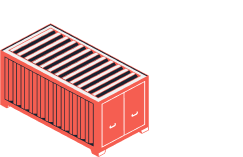
Full container load (FCL)
Definition: FCL (Full Container Load) shipping is a type of sea freight transport where a container is exclusively used for a single shipment. You get an entire container - be it a 20'ft or 40'ft container - to yourself, without sharing space with other shippers.
When to Use: FCL shipping is an excellent choice when your cargo is over the threshold of 13/14/15 CBM. It's economical for high-volume shipments, and with your goods exclusively occupying the space, they remain in a sealed container from origin to destination, enhancing your cargo's safety.
Example: Let's say, as a Thai manufacturer, you received a large order - around 400 chairs - to be shipped to Sweden. Your FCL shipping quote suggests that utilizing a 20'ft FCL container would comfortably accommodate your shipment, optimize your shipping cost efficiency, and securely deliver the order in the original condition.
Cost Implications: Although pricier than LCL (Less Container Load), FCL proves to be cheaper per unit as the shipment volume increases. You pay a flat fee per container, regardless of whether it’s fully loaded or not, making it a cost-effective choice for high volume goods.
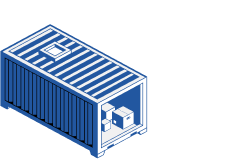
Less container load (LCL)
Definition: Less than Container Load (LCL) transport is when your shipment doesn't require a full container, sharing space with goods from other shippers. When to Use: This option is particularly useful when your shipment's volume is between 1 and 14 CBM. LCL shipment could mean cost efficiency and more flexibility, allowing businesses to transport smaller quantities without waiting to fill a full container. Example: For instance, if you're a Swedish retailer importing artisanal goods from Thailand. Your order quantity might not always fill a full shipping container. Instead of waiting or ordering more goods than necessary, you can opt for LCL freight. This way, you can keep your inventory lean while still meeting market demand. Cost Implications: While the cost per unit of space is typically higher in LCL than Full Container Load (FCL), it doesn't necessitate paying for unused space in a container. However, remember that LCL involves more handling due to consolidation at the origin port and deconsolidation at the destination port, which might increase the risk of damage to goods and can possibly incur additional charges.
Hassle-free shipping
Struggling with the cargo shipping maze between Thailand and Sweden? Let DocShipper handle the complexities. As experienced freight forwarders, we understand the factors that influence your choice: cost, delivery time, and cargo size. Our ocean freight experts work tirelessly to advise you on the best approach - consolidation or full container load. Ready to transform your shipping experience? Reach out to us for a free, no-obligation estimate, paving the way for a hassle-free shipping journey.
How long does sea freight take between Thailand and Sweden?
Sea freight shipping from Thailand to Sweden typically takes a range of 30 to 50 days on average. It’s essential to understand that these transit times aren’t fixed. They can vary depending on various factors such as the specific ports used, the weight of the shipment, and the nature of the goods being transported. If you’re looking for the most accurate estimate tailored to your specific shipment, we’d suggest contacting a professional freight forward specialist like DocShipper, who can provide precise and personalized quotes.
Here’s a straightforward table showing average transit times for sea freight between the main freight ports in Thailand and Sweden:
From To Average Transit Time (in days) Bangkok (TH) Stockholm (SE) 44 Laem Chabang (TH) Gothenburg (SE) 39 Map Ta Phut (TH) Malmo (SE) 41 Sattahip (TH) Helsingborg (SE) 39
*Please note that these times are average estimates and actual transit times may vary.
How much does it cost to ship a container between Thailand and Sweden?
Unveiling the exact ocean freight rates for shipping containers between Thailand and Sweden can feel like an enigma, primarily due to an array of variables. The precise location of your Point of Loading and Destination, the chosen carrier, the characteristics of your goods, and even monthly market fluctuations significantly influence the costs per CBM.
While we can indicate a broad shipping cost range, know that every business case is unique to us. Our shipping specialists are keen to study the intricacies of your requirements, delivering a tailored quote that ensures advantageous rates for your specific shipping needs. Be assured, we’ve got your shipping interests at heart.
Special transportation services
Out of Gauge (OOG) Container
Definition: An Out of Gauge (OOG) container, also known as Out of Gauge cargo, is designed for items that don’t fit typical sea freight containers due to excess weight or dimensions. Suitable for: Ideal for large, heavy, or irregular shaped goods that exceed standard container size. Examples: Large machinery, industrial equipment, generators, or wind turbine blades. Why it might be the best choice for you: If you’re dealing with oversized or overweight cargo from Thailand to Sweden, an OOG container allows for easy, secure, and efficient transportation.
Break Bulk
Definition: Break bulk means to separate out and transport goods individually, rather than in containers. It involves individual loading of goods directly onto the vessel. Suitable for: Most commonly used for cargo that is not containerized, such as timber, steel products, or machinery. Examples: Construction materials, building equipment, or cargoes of steel rods. Why it might be the best choice for you: If your goods aren’t suited or necessary for containerization, break bulk offers flexibility in handling different types of loose cargo load and often proves more cost-effective.
Dry Bulk
Definition: Dry Bulk shipping refers to transportation of significant quantities of bulk material, like minerals or grain, in its natural form without packaging. Suitable for: Commodities that can be poured and are shipped in large quantities, like coal, grain, or sand. Examples: Manufacturing materials such as iron ore, or agricultural products like rice or sugar. Why it might be the best choice for you: If you’re shipping large quantities of certain commodities between Thailand and Sweden that don’t require protective packaging, dry bulk offers an efficient and cost-effective method.
Roll-on/Roll-off (Ro-Ro)
Definition: The Roll-on/Roll-off (Ro-Ro) method involves vehicles or equipment with wheels being driven on and off a specialized ro-ro vessel. Suitable for: Cars, trucks, tractors, trailers, buses, or any equipment that are mobile. Examples: Transporting new or used vehicles, heavy machinery, or mobile construction equipment. Why it might be the best choice for you: If you’re shipping wheeled cargo, such as vehicles or rolling machinery, Ro-Ro enables direct drive on and off the ship, making it a quicker and safer shipping method.
Reefer Containers
Definition: Reefer containers are refrigerated shipping containers designed to transport temperature-controlled cargoes. Suitable for: Goods which require a certain temperature or humidity range for preservation such as perishable food, pharmaceuticals or certain chemicals. Examples: Fresh fruits and vegetables, fish, meat, dairy products, or sensitive medicines. Why it might be the best choice for you: If your goods from Thailand to Sweden need specific temperature control during transit, reefer containers offer a safe and reliable transportation method.
At DocShipper, we’re dedicated to helping businesses understand their international shipping options clearly. Contact us today for a free shipping quote processed in less than 24h, and let’s explore the best freight methods tailored to your unique needs.

Air freight between Thailand and Sweden
Are you looking to ship goods between Thailand and Sweden swiftly and securely? Then, air freight is your go-to choice. Known for unparalleled speed and reliability, air freight serves as a cost-effective solution for small, high-value shipments – think technology devices or fresh seafood.
However, the seemingly simple process of air freight can quickly transform into a maze, preying on unsuspecting shippers. What if you miscalculate the weight of your goods? Imagine paying to ship air, quite literally. It’s easy to overlook the intricacies – from utilizing the correct weight formula to understanding the best practices for cost-efficiency. We’ll dissect these challenges and more, ensuring you leverage air freight to its fullest potential.
Air Cargo vs Express Air Freight: How should I ship?
It can feel like a web of decisions when choosing between Air Cargo and Express Air Freight for your Thailand-Sweden shipments. Imagine Air Cargo like booking a shared ride with other passengers, roomy but slower, while Express Air Freight is akin to a private jet—exclusive, fast, yet pricier. With your specific needs in mind, let’s unfold these options to find your perfect mid-air match.
Should I choose Air Cargo between Thailand and Sweden?
If your freight weighs over 100kg (220 lbs), then choosing air cargo between Thailand and Sweden might make excellent business sense. Leading airlines such as Thai Airways and SAS offer reliable freight services, often proving more cost-effective as your shipment size increases. Do note that, while cost-effective, air cargo transit times can be longer due to airlines’ fixed schedules. But rest assured that with their significant cargo handling experience, your shipments are in trusted hands. Visit Thai Airways and SAS for more details. This choice can fit your budget and meet your shipping needs efficiently.

Should I choose Express Air Freight between Thailand and Sweden?
Express air freight is a tailored service using cargo-only planes, a rapid solution for collating smaller shipments—typically less than 1 CBM or 100/150 kg (220/330 lbs). Firms like FedEx, UPS, and DHL specialize in this, offering international express shipping. Express services offer unparalleled speed—ideal if your shipment between Thailand and Sweden is small but time-sensitive. Navigating customs also becomes seamless, as these courier companies often handle this as part of their service. Thus, for swift delivery and ease, express air freight could be your choice.

Main international airports in Thailand
Suvarnabhumi Airport
Cargo Volume: Suvarnabhumi Airport handles approximately 97,774 metric tons of cargo annually, making it one of the busiest cargo hubs in Southeast Asia.
Key Trading Partners: Principal trading partners are China, Japan, and the United States.
Strategic Importance: The airport’s proximity to Bangkok, a major Southeast Asian economic hub, aids efficient global supply chain networks.
Notable Features: Suvarnabhumi boasts the world’s tallest air traffic control tower and the world’s third largest single-building airport terminal. Their efficient cargo handling systems include automated storage and retrieval systems.
For Your Business: The airport’s modern facilities, high cargo handling capacity, and strategic location to major markets make it an excellent choice for air cargo transportation to and from Thailand.
Don Mueang International Airport
Cargo Volume: Don Mueang handles over 35,000 metric tons of cargo per year.
Key Trading Partners: Major trading partners include China, Japan, and Singapore.
Strategic Importance: Its established role as a regional commuting hub for low-cost carriers promotes cost-effective shipping options.
Notable Features: Don Mueang has well-equipped cargo terminals and is home to several cargo airlines, including FedEx Express.
For Your Business: Utilizing Don Mueang, especially for regional shipping, can significantly decrease shipment costs due to its popularity with low-cost carriers.
Phuket International Airport
Cargo Volume: Phuket International Airport manages close to 25,000 metric tons of cargo annually.
Key Trading Partners: Key trading partners predominantly include China, Australia, and Malaysia.
Strategic Importance: Being the second busiest airport in Thailand, Phuket is a major gateway to Thailand’s thriving southern region.
Notable Features: The airport has a dedicated freight terminal and is a major hub for fishery exports.
For Your Business: If your goods align with the common imports/exports in the region such as seafood, Phuket International Airport could be an interesting choice for your business.
Chiang Mai International Airport
Cargo Volume: Chiang Mai International Airport processes approximately 18,000 metric tons of cargo annually.
Key Trading Partners: The airport’s key trading partners primarily include China, South Korea, and Hong Kong.
Strategic Importance: As the gateway to the north of Thailand, the airport holds strategic importance due to the booming agricultural and high-tech industry in the region.
Notable Features: Chiang Mai is equipped with modern cargo facilities and handles exports of electronics, agricultural goods, and textiles.
For Your Business: Companies operating in the agriculture or high-tech industry looking to tap into Northern Thailand might find Chiang Mai International Airport especially useful for their shipping needs.
U-Tapao Rayong-Pattaya International Airport
Cargo Volume: U-Tapao Rayong-Pattaya International Airport has an increasing cargo volume of 30,000 tons, handling cargo primarily for freight carriers as well as passenger-cargo mixed flights.
Key Trading Partners: Key cargo trading partners include China, Japan, and India.
Strategic Importance: Situated in the Eastern Economic Corridor (EEC), it provides a gateway to this government-initiated hub for technological innovation and manufacturing.
Notable Features: Recent development plans have emphasized expansion of cargo capabilities, positioning U-Tapao as an up-and-coming cargo hub.
For Your Business: Businesses focused on technological advancement and keen on entering the burgeoning EEC might strategically benefit from using this evolving airport for their logistics requirements.
Main international airports in Sweden
Stockholm Arlanda Airport
Cargo Volume: Approximately 96,500 tons annually. Key Trading Partners: Germany, USA, Norway, Finland, and Denmark. Strategic Importance: It’s the largest airport in Sweden and serves as a major hub for international cargo, serving over 180 destinations worldwide. Notable Features: 24/7 cargo terminal operations and temperature-controlled facilities for special cargo. For Your Business: If wide global reach and flexible operating hours are key considerations for your shipping strategy, Stockholm Arlanda, with its extensive cargo-handling facilities, is well-suited for your business.
Göteborg Landvetter Airport
Cargo Volume: Approximately 60,100 tons annually. Key Trading Partners: UK, Germany, Denmark, and Finland. Strategic Importance: This is Sweden’s second-largest airport and the main international gateway for the west of Sweden. Notable Features: Direct connections to several European cities and the capacity to handle large and heavy cargo. For Your Business: As a hub with strong European connections, Göteborg Landvetter is ideal if your business primarily trades with European countries.
Malmö Airport
Cargo Volume: Approximately 24,000 tons annually. Key Trading Partners: Norway, Germany, UK, Denmark, and Belgium. Strategic Importance: The airport is strategically located in the Oresund region, enabling access to the Danish market. Notable Features: Handles both regular and ad hoc freighter operations. For Your Business: If your business trades significantly within the Oresund region, Malmö’s location can provide compelling strategic benefits for your business’s shipping operations.
Linköping City Airport
Cargo Volume: Primarily handles cargo charter flights. Key Trading Partners: Predominantly European countries. Strategic Importance: This airport is located in a primary centre for the Swedish aviation industry. Notable Features: It provides specialized logistics solutions for aviation parts and other specific industries. For Your Business: If your business operates within the aviation industry or requires specialized logistic solutions, Linköping City provides niche services tailored to your needs.
Umeå Airport
Cargo Volume: Significant, though precise statistics are not published. Key Trading Partners: Primarily northern Europe, specifically Finland and Norway. Strategic Importance: Key airport for the north of Sweden, providing valuable connections to the region and beyond. Notable Features: Has facilitated a rise in e-commerce transit and is equipped to handle wide-ranging cargo types. For Your Business: If your business operates within or serves the northern European market, Umeå Airport’s strategic location and e-commerce capabilities could significantly aid your shipping operations.
How long does air freight take between Thailand and Sweden?
Average air freight shipping times between Thailand and Sweden typically hover around 1-3 days. However, it’s essential to note that these timelines can fluctitate based on various factors. For instance, your specific departure and arrival airports, the weight and size of your cargo, plus the nature of the goods you’re shipping, can all impact transit times. For pinpoint accuracy on your shipping timelines, it’s best to consult with a dependable freight forwarder, such as DocShipper.
How much does it cost to ship a parcel between Thailand and Sweden with air freight?
Transporting an air freight parcel from Thailand to Sweden largely varies, but the average price range could be anywhere between $3 to $8 per kg. The exact cost, however, is affected by several factors such as distance from airport of departure and arrival, parcel dimensions, and weight, as well as nature of goods. This is why every estimate we offer is tailored to your specific requirements. Be assured, our team dedicates its effort to provide the best rates possible. Contact us today, and receive your free quote within 24 hours.
What is the difference between volumetric and gross weight?
If you’re shipping goods between Thailand and Sweden, you’ll need to understand two terms: gross weight and volumetric weight. Gross weight refers to the actual weight of your shipment, including all packaging. Volumetric weight, sometimes called dimensional weight, considers the space your package takes up on an aircraft.
Air cargo carriers calculate gross weight in kilograms (kg), by simply weighing the entire package. For example, if your shipment, including its packaging, weighs 65 kg, this is your gross weight. In pounds, that’s about 143 lbs.
Volumetric weight is a bit more complicated. For Air Freight, it’s calculated using this formula: Length (cm) x Width (cm) x Height (cm) / 6000 = Volumetric Weight (kg). In the world of Express Air Freight, this denominator changes from 6000 to 5000.
So, imagine your package measures 50 cm x 50 cm x 50 cm. In Air Freight, the calculation is 505050/6000. This gives you a volumetric weight of approximately 21 kg, which is roughly 46 lbs.
With Express Air Freight the formula is 505050/5000, leaving you with a volumetric weight approximately of 25 kg or roughly 55 lbs.
Why does this matter? Quite simply, your freight charges depend on it. Carriers will take both weights into consideration, and charge based on whichever is greater. By calculating these yourself, you can get a ballpark estimate of your shipping costs and avoid unexpected surprises.

Door to door between Thailand and Sweden
Door to Door shipping streamlines global logistics, taking your cargo from heartland Thailand right to your Swedish doorstep. This complete package bundles together transportation, customs clearance, and delivery, easing the hassle while saving time and effort. Let’s unbox the benefits this remarkable shipping method can offer for your Thailand-Sweden route. Ready? Let’s dive in!
Overview – Door to Door
Shipping between Thailand and Sweden can feel like navigating a maze, but our door-to-door service simplifies this endeavor significantly. No need to juggle multiple logistic partners, we handle everything – pick up at origin, customs clearance, and delivery. You enjoy peace of mind, budget predictability, and stress-free logistics solutions our clients appreciate greatly.
On the flip side, fewer shipment tracking opportunities may disappoint some. But remember, both destination countries have specific, challenging customs procedures. Thus, keeping it all under one umbrella can alleviate these complexities. Explore why door-to-door shipping could be your game-changing decision.
Why should I use a Door to Door service between Thailand and Sweden?
Feeling like logistics have turned you into a juggling act? Well, let that be a worry of the past. Door to Door service between Thailand and Sweden might be your logistics hero. Here are five reasons why you should consider it.
1. Stress-Free Logistics: With Door to Door service, you can wave goodbye to the complex task of coordinating different shipping steps. The service takes care of everything from picking up your goods to delivering them to the final address.
2. Timely Delivery: Urgent shipments require a reliable solution. This service not only promises trackable, swift delivery but ensures your goods are transported with punctuality, keeping business timelines intact.
3. Specialized Handling: Got complex cargo? Door to Door service comes with the expertise to handle it all. From fragile items to bulky goods, dedicated professionals ensure your items are in safe hands throughout the journey.
4. Convenience: Because who doesn’t want more of it? The service goes the extra mile (literally!) handling trucking at both origin and destination. You get to focus on your business, leaving the logistics headache to the experts.
5. Comprehensive Coverage: Forget worrying about customs, documentation, or dealing with multiple transport providers. Everything is handled by a single, accountable entity which delivers your goods from – you guessed it – door to door.
Let’s hear it for smoother, stress-free logistics!
DocShipper – Door to Door specialist between Thailand and Sweden
Experience stress-free, door to door shipping from Thailand to Sweden with DocShipper. As experts in the field, we meticulously manage every aspect of your goods transportation – packing, transport, customs, and choosing the ideal shipping method. Our exceptional proficiency ensures smooth processes while a dedicated Account Executive provides personalized guidance all along. Reach out for a no-obligation, free estimate in less than 24 hours or consult with our experts at no cost. Trust us, you won’t have to lift a finger!

Customs clearance in Sweden for goods imported from Thailand
Customs clearance is a complex but essential process for effective goods transportation. As you import goods from Thailand to Sweden, it’s a labyrinth of unexpected fees, potential holdups and mandatory requirements for your goods at the Swedish border. From properly understanding customs duties, taxes, and quotas, to securing the necessary licenses, there’s a lot that can result in your goods getting detained. Knowing every step can save you time and money, which we’ll cover in-depth in the following sections.
Fortunately, DocShipper is there to assist with this intricate process for any goods worldwide. Provided you have the origin, value, and HS Code of your goods, contact us for an initial estimate to help plan your project seamlessly. Successful clearance is achievable, let’s delve into how.
How to calculate duties & taxes when importing from Thailand to Sweden?
Understanding how to estimate duties and taxes when importing goods from Thailand to Sweden can feel like a puzzle, but every piece fits into place once you know what you’re looking for. The key elements to consider are the country of origin, the Harmonized System (HS) code of your merchandise, Customs Value, the Applicable Tariff Rate, and any additional taxes or fees that may be applicable to your specific scenario.
A crucial first step is pinpointing the actual manufacturing or production country of your goods. If, for instance, the items were produced in Thailand, then that is the country of origin to be specified. Knowing this can be a stepping stone towards deciphering the usually complex customs costs.
Step 1 – Identify the Country of Origin
First, pinpointing your goods’ country of origin, in this case, Thailand, is a must for calculating duties and taxes effectively. Why? Here are five reasons.
1. It aids tariff classification: The tariff number (HS code) is based on the actual item and its origin. 2. It guides you to the right product-specific exemptions and concessions, potentially saving you money. 3. Allows you to apply the right rules of origin and take advantage of preferential treatments, if any. 4. Ensures compliance with trade policy laws and prevents investigation issues in custom. 5. Determines compliance with local standards or other specifications or packaging requirements.
Thailand and Sweden have an agreement under ASEAN-EU. This means, depending on the product, duties could get significantly reduced or even abolished.
Consider also Sweden’s import restrictions. Is your product on this list? Seek advice if unsure; it prevents nasty surprises.
Never overlook this step. It provides the structure for all subsequent actions and mistakes here can cause unnecessary expense and delays. Make the most of our guide to avoid missteps and maximize your bottom line, every time!
Step 2 – Find the HS Code of your product
A Harmonized System (HS) Code is a universally recognized code that classifies traded products. Developed by the World Customs Organization, these codes provide a standardized system of names and numbers to classify traded products and are used by customs authorities around the world to identify products for tax and regulatory purposes.
If you need assistance to find the HS code for your product, the quickest approach is usually to consult with your supplier. They are generally familiar with the product they’re importing, including all relevant codes and regulations.
In situations where this isn’t feasible, you can take matters into your own hands by following a straightforward step-by-step process:
1. Use an HS lookup tool. We recommend the Harmonized Tariff Schedule – a reliable and easy-to-use tool. 2. Type your product name into the search bar 3. Locate the Heading/Subheading column – this is where you can find your product’s HS code.
Accuracy is crucial when it comes to HS Codes. A simple mistake in your HS code selection can lead to importation delays, incorrect duty and tax calculations, or even unwanted fines! Make sure to double-check before continuing with the shipment process.
Here’s an infographic showing you how to read an HS code.

Step 3 – Calculate the Customs Value
In the world of international shipping, it’s crucial to understand that the customs value differs from the product’s market price. Now, you may be wondering, ‘What’s customs value anyway?’ Simply put, it’s an amount that reflects the transaction value of your goods, the cost of shipping them internationally, and the cost of insurance. This total is often referred to as CIF (Cost, Insurance, and Freight) value.
So, if you bought goods worth $1000, paid $200 for shipping, and $50 for insurance, your customs value would be $1250 USD. With these figures, the Swedish customs will determine the amount of import taxes you’ll owe. Keep in mind, a clear understanding of customs value can help you avoid unexpected expenses and make your import process much smoother.
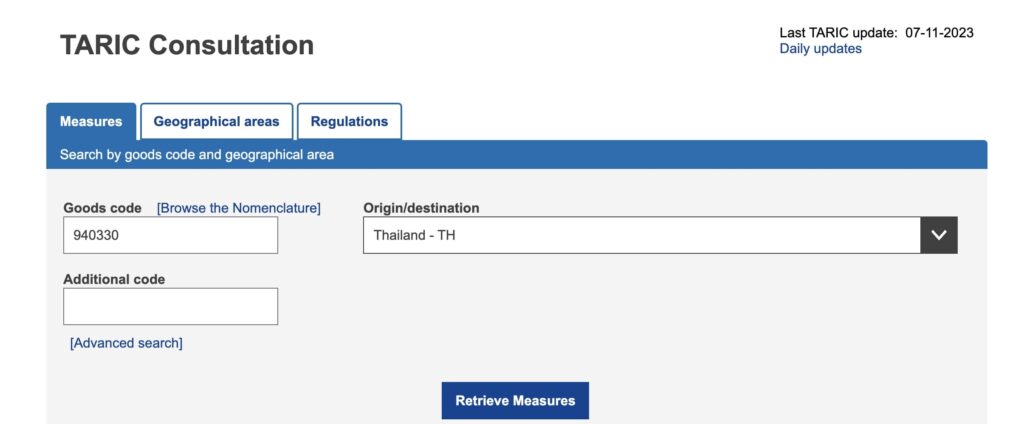
Step 5 – Consider other Import Duties and Taxes
It’s crucial to bear in mind that the customs clearance process isn’t solely about standard tariffs. Additional duties frequently apply based on the product’s nature and originating country.
Consider excise duties, employed on goods like alcohol or tobacco; these are over and above your regular customs duties. For example, if you were to import whiskey from Thailand to Sweden, you’d need to account for the standard tariff and the applicable excise duty. Remember, this is just an example and actual rates can vary.
Then, there are anti-dumping taxes. These kick in if your goods are significantly cheaper than the same or similar products in the EU, potentially to protect local industries. So, if you’re considering the import of cost-competitive Thai engine parts, additional fees could apply.
Most critical in our discussion is Sweden’s VAT rate, applied to the total value of the goods, including duties and taxes. As a general formula, if the CIF (Cost, Insurance, and Freight) value of your goods is $1000 and the total duty comes to $200, your VAT would be calculated on $1200.
Keep in mind, we’ve provided examples here and rates could differ. Alleviate your shipping concerns with thorough research and professional advice to ensure your international trade runs smoothly.
Step 6 – Calculate the Customs Duties
At Step 6, understanding customs duties calculation is crucial for shipments from Thailand to Sweden. It starts with your goods’ customs value (product price + shipping cost + insurance). Then, specific customs and excise duties are applied, varying by product category.
For example, if a $1,000 product has a customs figure of 5%, your payable duty is $50, with VAT (25% in Sweden) not assigned. In your second scenario, suppose the same product’s VAT also applies. In that case, your duty remains $50, while your VAT is computed on the total value the goods ($1,000) plus the customs duty ($50), i.e., $262.50. Lastly, with anti-dumping taxes and excise duty, if the product incurs a 4% anti-dumping tax and a $200 excise duty, both are added straight to your customs duty, resulting in a $240 addition.
Navigating through customs can be time-consuming and complex. Leave the hassle to us. At DocShipper, we handle every step of your customs clearance efficiently anywhere across the globe, ensuring you pay no extra dime! Reach out for a free quote within 24 hours.
Does DocShipper charge customs fees?
Though DocShipper is a customs broker in Thailand and Sweden, we don’t charge customs duties – those fees go straight to policymakers in government. What we bill for is the customs clearance process: handling paperwork, coordinating shipments, and ensuring compliance with laws. We transparently provide you with the customs invoice, so rest assured, you’re only paying your fair government dues. Think of it this way, if customs duties are the restaurant bill, then the customs clearance fees are the tip for the server – you’re paying for their professional service.
Contact Details for Customs Authorities
Thailand Customs
Sweden Customs
Required documents for customs clearance
Facing stack of paperwork and confusion on what’s needed for customs clearance? This section takes confusion out of the equation. We’ll demystify the Bill of Lading, Packing List, Certificate of Origin, and the Documents of Conformity (CE standard). Get the right documents in hand for a smooth clearance process. No more guesswork, no more delays. Let’s make this daunting task a breeze for you!
Bill of Lading
When shipping goods from Thailand to Sweden, you’ll find the Bill of Lading (BOL) crucial. This isn’t just any document; it’s the seal on the deal, the moment the baton passes from the hands of the seller to the buyer. Just as a relay team can’t win without passing the baton, your goods cannot cross borders effectively without a BOL. It’s like your product’s passport, born in Thailand and ready to live its new life in Sweden.
For a smoother experience, consider electronic ‘telex’ release. Telex simplifies ownership transition, saving time and money. It’s the sprinter running on the home stretch, ensuring your race to international shipping glory isn’t hampered. And, if you’re teaming with the skies, you’ll need an Air Waybill (AWB), the BOL’s cousin, underscoring seamless air cargo trips. Remember, the devil is in the details, understand your BOL requirements and your goods will reach their destination sans unexpected delays.
Packing List
Shipping goods from Thailand to Sweden? The Packing List is your sidekick in this adventure. Imagine it as the biography of your shipment. Details like weight, dimensions, content types, and quantities – everything about your goods’ physical character goes there. It’s like telling customs officers, ‘Here’s what to expect in the box!’ Accuracy? It’s not just important; it’s a necessity.
Whether you choose ocean waves or sky routes for your goods, the packing list follows. Skimping on details might lead to delays in the journey of your consignment, whether it’s a load of textiles destined for Stockholm or intricately crafted jewelry for Gothenburg. So, keep that Packing List precise and honest for a smooth sailing (or flying!) journey.
Commercial Invoice
Navigating the customs process between Thailand and Sweden? A robust Commercial Invoice is key. This crucial document provides comprehensive information about your shipped goods, including the total cost, product description, and destination, all important details for customs officials.
A common challenge? Alignment with other paperwork. Make sure your Commercial Invoice matches all data in your Bill of Lading or Air Waybill to avoid customs issues. For example, if you’re shipping electronics, ensure the product codes and prices tally across all documents. This seamless coordination can help expedite clearance, facilitating a smooth delivery of your goods to Scandinavian shores.
Certificate of Origin
Ready to ship goods from Thailand to Sweden? The Certificate of Origin (CoO) is a must-have. It’s your golden ticket to potentially lower customs duties, proving your goods are truly ‘Made in Thailand’. Picture it as your product’s passport, mentioning its country of manufacture. Let’s say you’re shipping premium Thai silk. Your CoO authenticates your claim, opening doors to preferential duty rates under trade agreements. So, before you get your goods onboard, ensure you have the CoO handy. It’s not just a document, but a cost-saving tool in your international business.
Certificate of Conformity (CE standard)
The Certificate of Conformity (CE standard) is an essential cog in the shipping process from Thailand to Sweden. It’s not about quality assurance but a directive that your product complies with EU standards, akin to the FCC Declaration of Conformity in the US. Imagine this like a passport for your goods, without which, they can’t enter the European market. It’s a prerequisite that guarantees your product’s safety, health, and environmental standards.
So, when packing up, consider this certification as a top-priority document, non-negotiable for successful customs clearance. It’s a best practice to verify your product’s eligibility before exporting to save time and avoid potential non-compliance fines. Remember, your business reputation is on the line! For goods intended for the UK, note the separate UKCA marking as they are no longer in the EU.
Your EORI number (Economic Operator Registration Identification)
Imagine shipping your goods from Thailand to Sweden, only to hit a bureaucratic wall at customs. Your solution? An EORI Number. This unique identifier is crucial in tracking imports and exports within the EU, and yes, Sweden is part of the EU. It’s like your business’s passport, smoothing the process of transporting goods across borders.
But be mindful, without an EORI number, your shipments may languish at customs, resulting in delays and potential extra costs. Acquiring one isn’t too complicated either – apply online through the Swedish Customs website and within a few working days, voila, you’re all set to simplify your international trade endeavors, ensuring that your goods journey from Thailand to Sweden is as seamless as possible.
Get Started with Siam Shipping
Prohibited and Restricted items when importing into Sweden
Avoid unexpected hurdles in your shipping journey to Sweden! Knowing what you can’t send is as crucial as knowing what you can. Our guide lists items that are either off-limits or need special permission, helping you dodge fines and delays. Dive in!
Are there any trade agreements between Thailand and Sweden
Yes, Sweden, being a member of the European Union (EU), is party to the EU-Thailand Free Trade Agreement negotiations. These discussions aim to eliminate tariffs and reduce trade barriers, which could lead to cost-effective freight options for your business. However, it’s crucial to note these talks are ongoing. Sweden is also an active participant in the Asia-Europe Meeting (ASEM), promoting trade, investment, and overall cooperation between Europe and Asia. Keep an eye on these developments as they could impact your shipping decisions between Thailand and Sweden.
Thailand – Sweden trade and economic relationship
Thailand and Sweden have long maintained a robust trading partnership, which dates back to the late-19th century. This relationship intensified in the 1960s, with the signing of the Agreement on Economic, Industrial, and Technical Cooperation. In recent years, their mutual trade volume has grown significantly, largely encompassing machinery, automotive parts, and electronics from Sweden, while Thailand contributes with top-quality seafood and textiles.
Aside from sectorial trading, investment relations are also flourishing. Swedish companies have invested over $1 billion in Thailand, particularly in manufacturing and services sectors, marking significant economic milestones. Meanwhile, Thailand’s investment in Sweden totals around $54 million, focusing primarily on the technology sector. Moreover, Thailand’s exports to Sweden have reached $565 million in 2021, and is Sweden’s largest trade partner in South East Asia. With this symbiotic relationship, both nations continue expanding their economic footprint, catering to each other’s market requisitions while forging a stronger global presence.
Your first steps with Siam Shipping
Additional logistics services
Warehousing
Finding reliable storage when shipping goods between Thailand and Sweden might feel like a minefield. Let's not forget the key role of temperature control for sensitive goods. The good news? We've cracked the code on warehousing solutions tailored to your unique needs. More info on our dedicated page: Warehousing.
Packing
When shipping goods from Thailand to Sweden, correctly packaging and repackaging your items is key to their safe delivery. A trustworthy agent, like ours, ensures your products are secured, whether it's delicate ceramics or heavy machinery. For example, antiques require custom crates, while electronics need anti-static bubble wrap. More info on our dedicated page: Freight packaging.

Transport Insurance
Cargo insurance is your safeguard during the unpredictable shipping journey, going steps beyond ordinary fire insurance. It provides a safety net against mishaps such as transit damage, theft, or lost goods. For instance, if an ocean storm damages your shipment of handmade Thai silk bound for Stockholm, cargo insurance can save your business from big losses. Protect your investment and have peace of mind. More info on our dedicated page: Cargo Insurance.
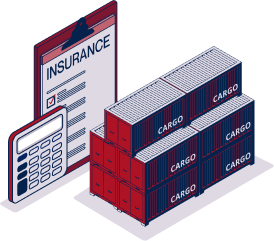
Household goods shipping
Moving treasured items from Thailand to Sweden? Our Personal Effects Shipping ensures your cherished, fragile, or bulky goods are cared for like our own. Imagine shipping your grandmother's piano or vintage wine collection with extreme professional delicacy. Plus, bulky items like furniture are no match for our honed flexibility. For peace of mind when it matters most, get more info on our dedicated page: Shipping Personal Belongings.
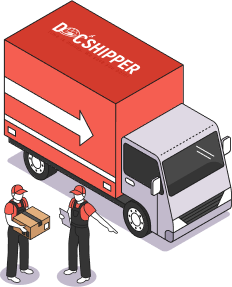
Procurement in Thailand
Looking to source goods from Asia or East Europe? DocShipper is your ally, assisting you in identifying suitable suppliers and managing the entire procurement process. We make overcoming language barriers our business, guiding you every inch of the way. Consider the Thai local firm seeking Swedish sustainable pine; we facilitate that logistical leap with ease. Intrigued? Dive deeper into our approach on our dedicated page: Sourcing services.

Quality Control
Quality control is vital in shipping goods from Thailand to Sweden, mitigating risks of delivering sub-standard products. Imagine custom-made Thai silk reaching Swedish retailers only to find an off-color dye - a disastrous scenario thwarted by strict quality inspections. Ensure your goods satisfy both Thai and Swedish standards with our detailed checks. More info on our dedicated page: Quality Inspection.
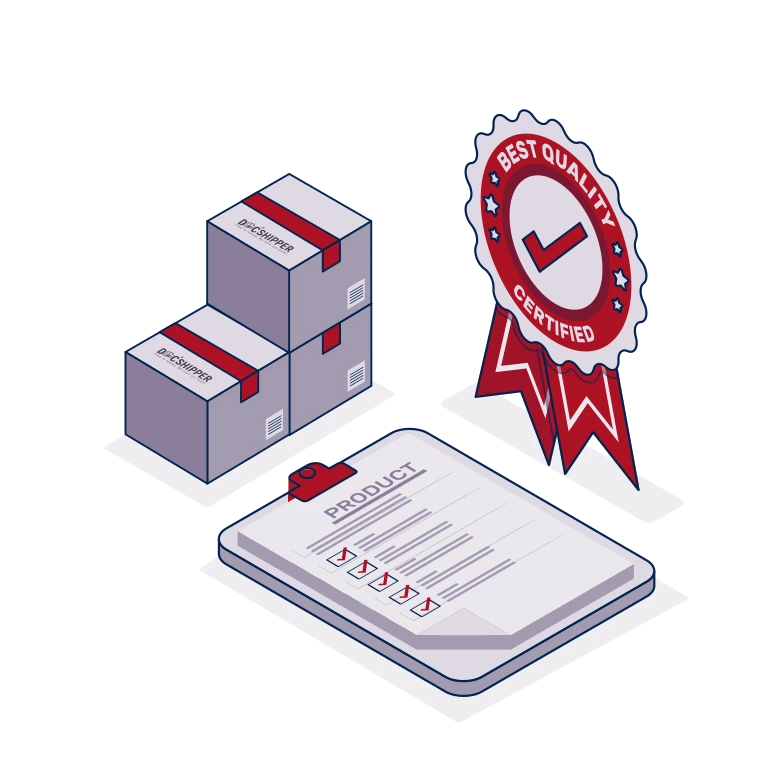
Conformité des produits aux normes
Product compliance can make or break your cargo's journey. Our lab tests grant certifications, validating that your products meet all necessary regulations. Imagine having your tech devices stalled because of non-compliant batteries. Avoid such mishaps and ship confidently. More info on our dedicated page: Product Compliance Services.







